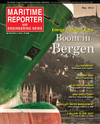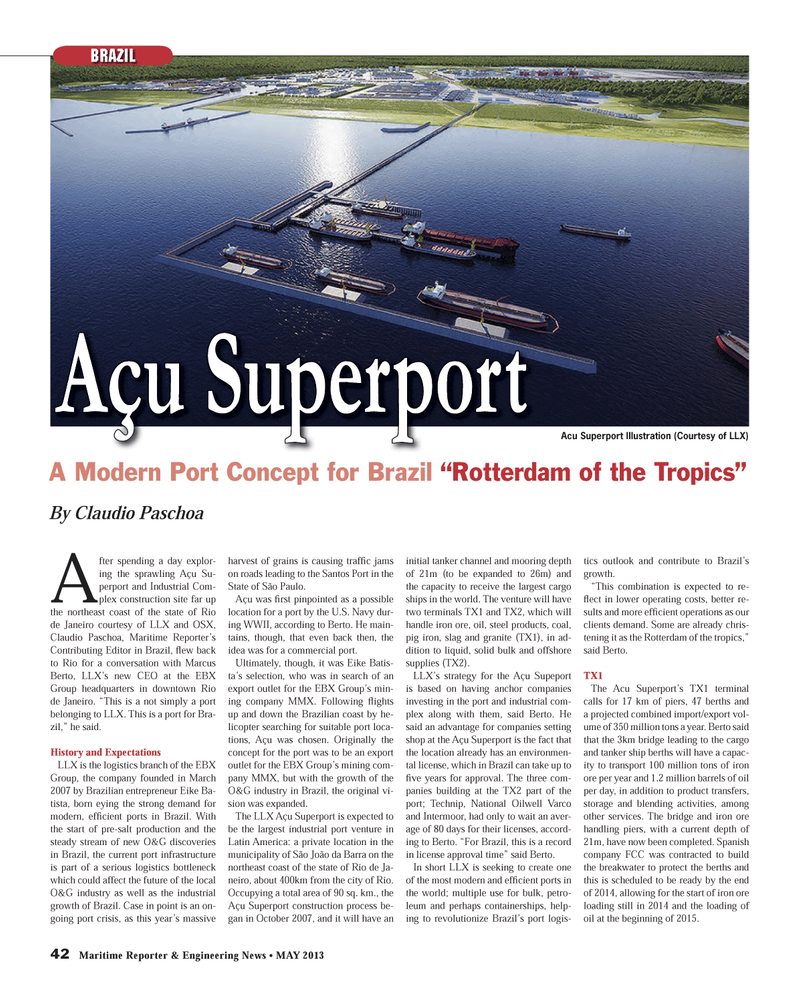
Page 42: of Maritime Reporter Magazine (May 2013)
Energy Production & Transportation
Read this page in Pdf, Flash or Html5 edition of May 2013 Maritime Reporter Magazine
42 Maritime Reporter & Engineering News ? MAY 2013 BRAZILAfter spending a day explor- ing the sprawling Açu Su- perport and Industrial Com-plex construction site far up the northeast coast of the state of Rio de Janeiro courtesy of LLX and OSX, Claudio Paschoa, Maritime Reporter?s Contributing Editor in Brazil, ß ew back to Rio for a conversation with Marcus Berto, LLX?s new CEO at the EBX Group headquarters in downtown Rio de Janeiro. ?This is a not simply a port belonging to LLX. This is a port for Bra- zil,? he said.History and ExpectationsLLX is the logistics branch of the EBX Group, the company founded in March 2007 by Brazilian entrepreneur Eike Ba-tista, born eying the strong demand for modern, efÞ cient ports in Brazil. With the start of pre-salt production and the steady stream of new O&G discoveries in Brazil, the current port infrastructure is part of a serious logistics bottleneck which could affect the future of the local O&G industry as well as the industrial growth of Brazil. Case in point is an on-going port crisis, as this year?s massive harvest of grains is causing trafÞ c jams on roads leading to the Santos Port in the State of São Paulo. Açu was Þ rst pinpointed as a possible location for a port by the U.S. Navy dur- ing WWII, according to Berto. He main- tains, though, that even back then, the idea was for a commercial port. Ultimately, though, it was Eike Batis- ta?s selection, who was in search of an export outlet for the EBX Group?s min- ing company MMX. Following ß ights up and down the Brazilian coast by he-licopter searching for suitable port loca-tions, Açu was chosen. Originally the concept for the port was to be an export outlet for the EBX Group?s mining com- pany MMX, but with the growth of the O&G industry in Brazil, the original vi-sion was expanded.The LLX Açu Superport is expected to be the largest industrial port venture in Latin America: a private location in the municipality of São João da Barra on the northeast coast of the state of Rio de Ja-neiro, about 400km from the city of Rio. Occupying a total area of 90 sq. km., the Açu Superport construction process be-gan in October 2007, and it will have an initial tanker channel and mooring depth of 21m (to be expanded to 26m) and the capacity to receive the largest cargo ships in the world. The venture will have two terminals TX1 and TX2, which will handle iron ore, oil, steel products, coal, pig iron, slag and granite (TX1), in ad-dition to liquid, solid bulk and offshore supplies (TX2).LLX?s strategy for the Açu Supeport is based on having anchor companies investing in the port and industrial com-plex along with them, said Berto. He said an advantage for companies setting shop at the Açu Superport is the fact that the location already has an environmen-tal license, which in Brazil can take up to Þ ve years for approval. The three com- panies building at the TX2 part of the port; Technip, National Oilwell Varco and Intermoor, had only to wait an aver- age of 80 days for their licenses, accord-ing to Berto. ?For Brazil, this is a record in license approval time? said Berto. In short LLX is seeking to create one of the most modern and efÞ cient ports in the world; multiple use for bulk, petro-leum and perhaps containerships, help-ing to revolutionize Brazil?s port logis- tics outlook and contribute to Brazil?s growth.?This combination is expected to re-ß ect in lower operating costs, better re- sults and more efÞ cient operations as our clients demand. Some are already chris-tening it as the Rotterdam of the tropics,? said Berto.TX1The Acu Superport?s TX1 terminal calls for 17 km of piers, 47 berths and a projected combined import/export vol-ume of 350 million tons a year. Berto said that the 3km bridge leading to the cargo and tanker ship berths will have a capac-ity to transport 100 million tons of iron ore per year and 1.2 million barrels of oil per day, in addition to product transfers, storage and blending activities, among other services. The bridge and iron ore handling piers, with a current depth of 21m, have now been completed. Spanish company FCC was contracted to build the breakwater to protect the berths and this is scheduled to be ready by the end of 2014, allowing for the start of iron ore loading still in 2014 and the loading of oil at the beginning of 2015.Açu Superport Açu Superport A Modern Port Concept for Brazil ?Rotterdam of the Tropics? By Claudio PaschoaAcu Superport Illustration (Courtesy of LLX) MR #5 (42-49).indd 42MR #5 (42-49).indd 425/2/2013 9:50:33 AM5/2/2013 9:50:33 AM

 41
41

 43
43
